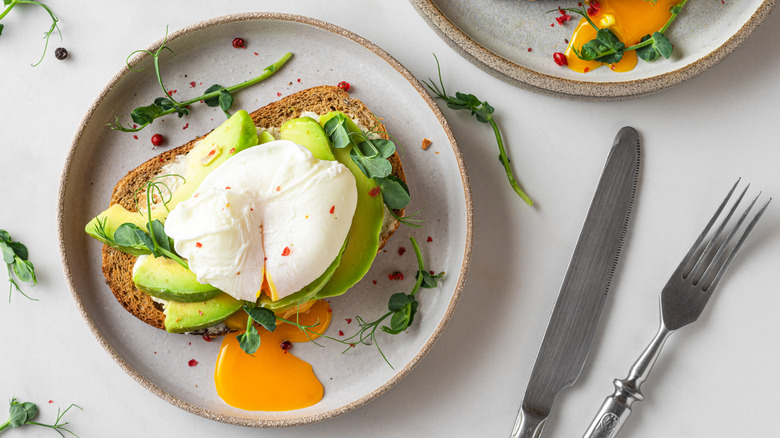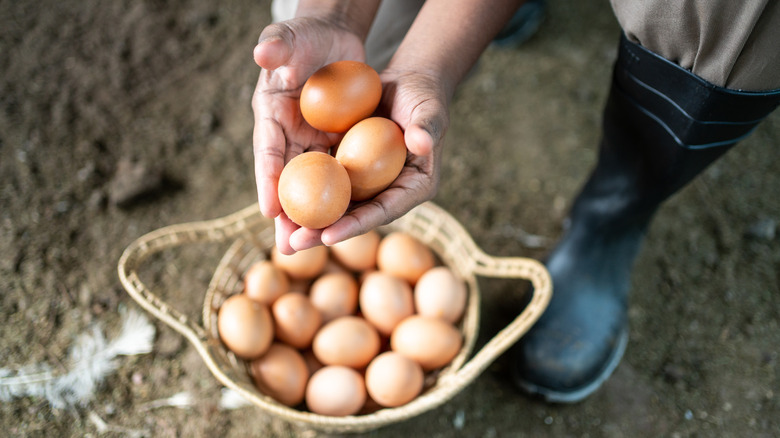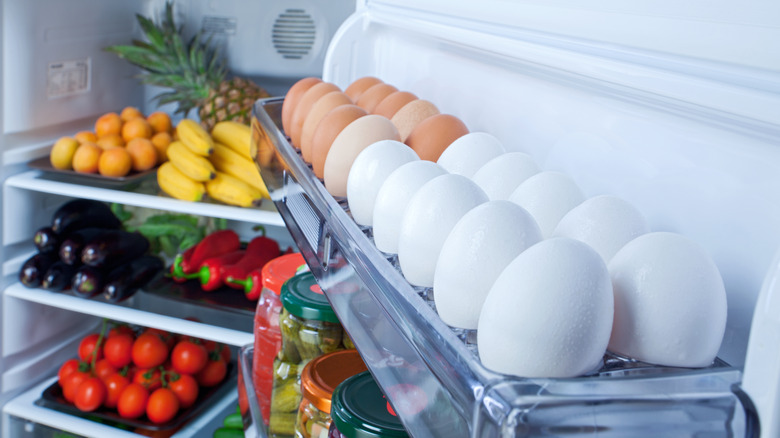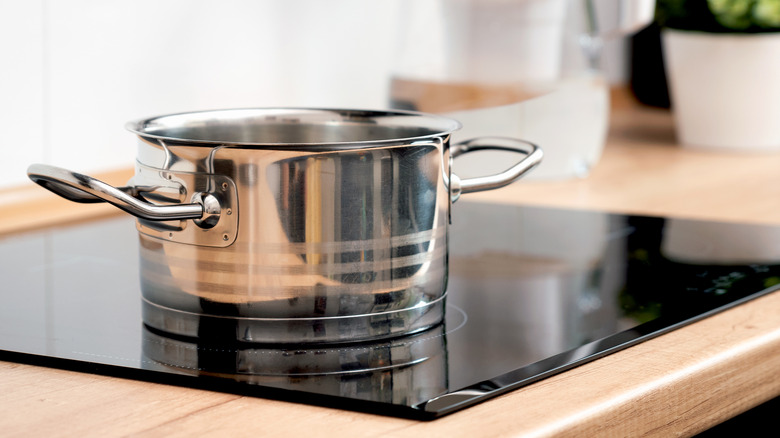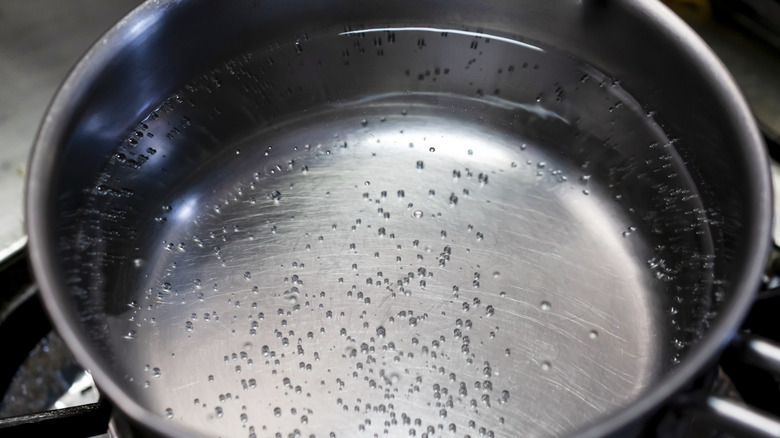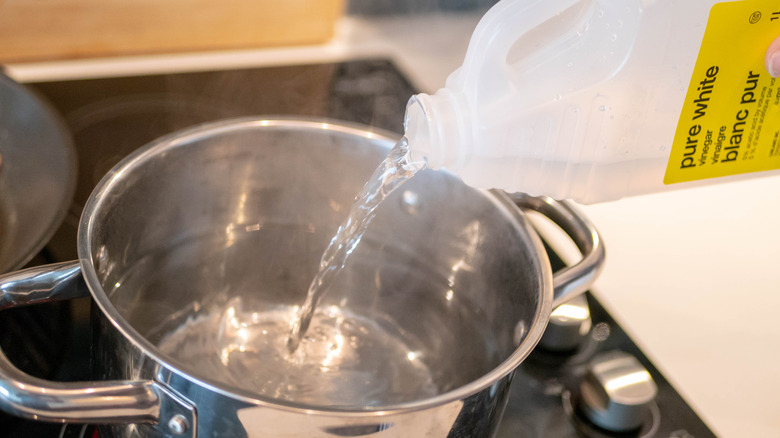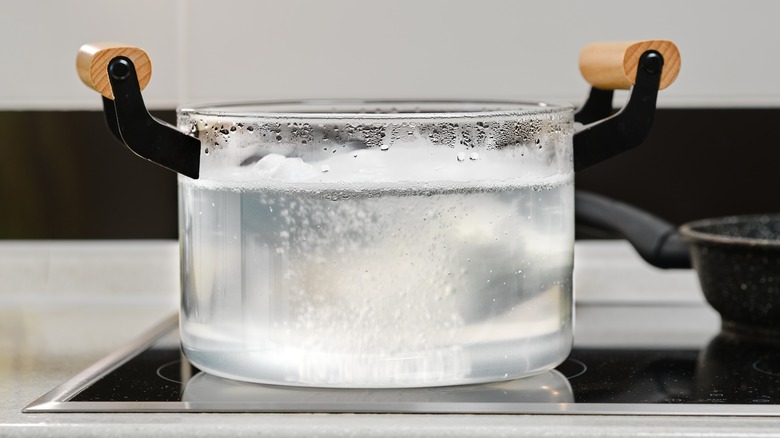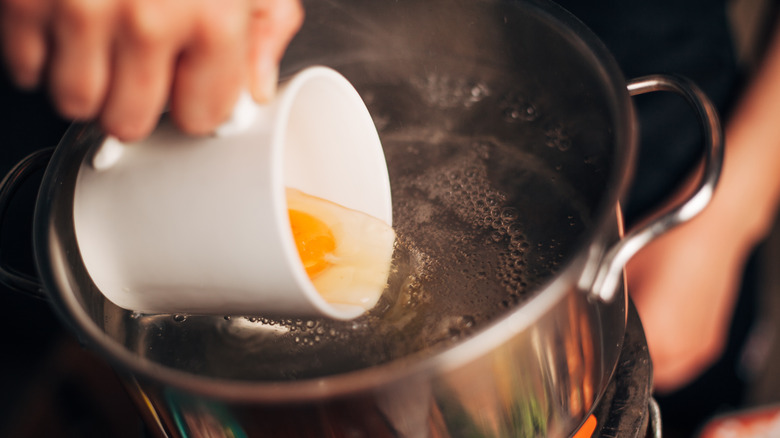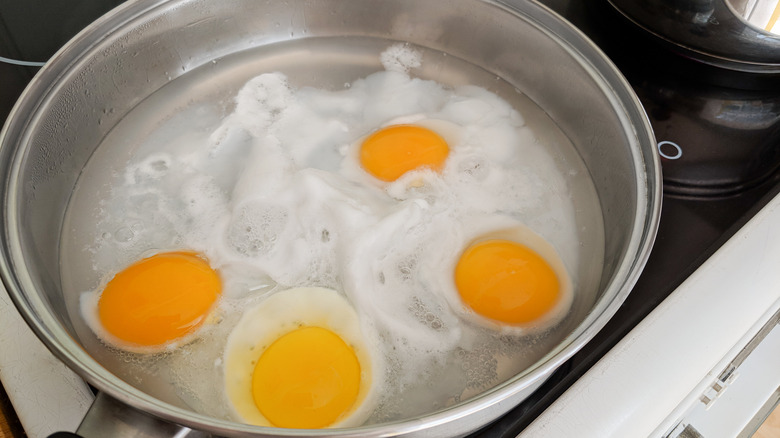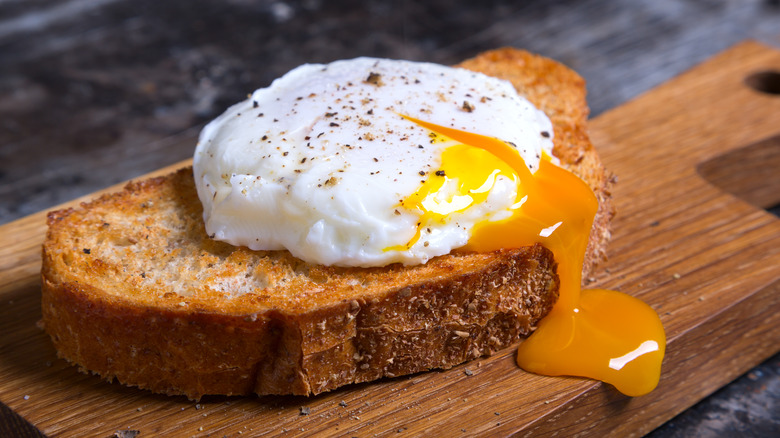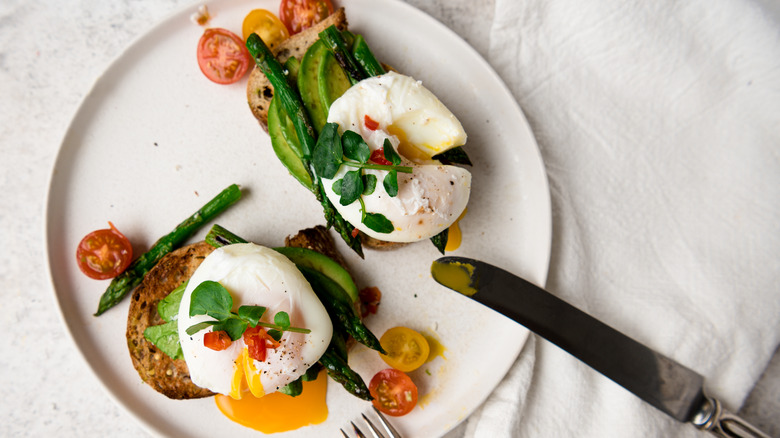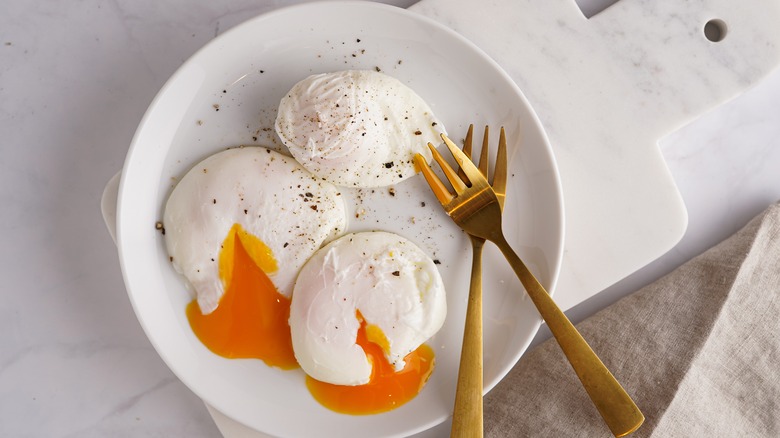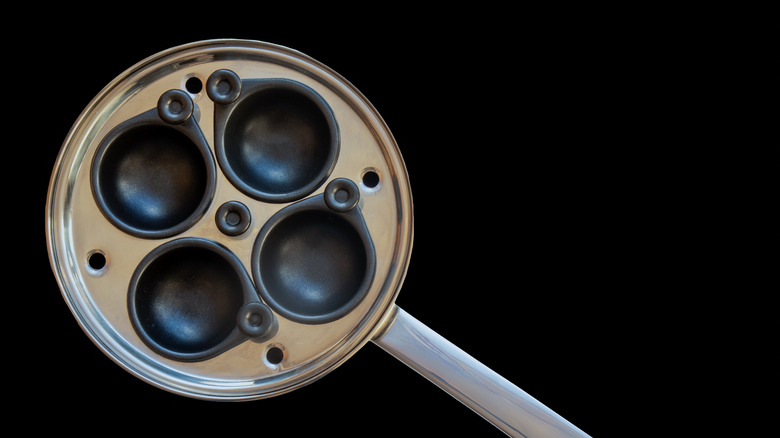How To Make The Best Poached Egg Every Single Time
What's on your ideal brunch menu? Waffles? Bacon? A mimosa or two? Whatever you're envisioning, chances are, there are poached eggs involved. These miraculous parcels of silky egg whites encasing runny, golden yolks are a non-negotiable feature of decadent brunches, but making them might seem like a specialized skill reserved for upscale restaurants and seasoned food bloggers. On a basic level, poaching involves cooking an egg in simmering water until the outside is set but the inside remains liquid. It is a difficult balance to strike, and there are plenty of pitfalls. Chief among them is that the whites can disperse into the water instead of coagulating around the yolk, leaving you with a cooked yolk and wisps of floating, rubbery white.
To avoid an overcooked, deconstructed egg, there are numerous factors to consider, from vinegar and water temperature to the freshness of the egg and the height from which you drop it into the water. You might've seen people skipping the hassle altogether, using a shortcut, or making imitation poached eggs in muffin tins or the microwave. But we spoke with several experts to break down the traditional process into simple steps that even the most inexperienced home cook can master. Though it may be intimidating at first, poaching an egg to perfection is highly achievable, and we've got all the tips you need to do it. So the next time you're craving eggs for breakfast, don't just fall back on scrambled eggs. Take a crack at poaching instead.
Start with fresh eggs
You can keep unbroken eggs in the refrigerator for up to five weeks, according to the U.S. Department of Agriculture, but when it comes to poaching them, you should use the freshest available. This isn't because they taste better or have more nutrients. In fact, eggs do not lose nutrients over time as long as they're raw and in their shells (per Fresh Eggs Daily). The reason you should use fresh ones for poaching is that they hold together better.
"The fresher the egg, the sturdier it is when poaching," explained Jessica Gavin, a culinary scientist and food blogger. "Older eggs have thinner whites that create [wisps] on the edges when cooked. The yolk also has more potential for breakage as the chalazae cord that holds it in place weakens." Getting the white to coagulate around the yolk when poaching is challenging enough when the egg is fresh, but attempting to do it with whites that are already prone to floating off in all directions the moment you drop it in the water is setting you up for failure.
In Gavin's experience, using an older egg forces you to be "much more delicate when moving [it] in the water as the components are more fragile." This means that bringing the water to a simmer and creating a vortex –- steps that normally help to coagulate the egg –- may just turn the white into a watery scramble. Save those older eggs for boiling or intentional scrambling.
Keep the eggs cold
To set yourself up for even greater success, leave the eggs in the refrigerator until you're ready to use them. Eggs should be kept chilled anyway to preserve freshness, but if you do a lot of baking, it might be second nature to bring eggs to room temperature before you start a recipe because doing so makes them easier to incorporate into batter. When it comes to poaching, however, you want the eggs to be cold.
Like just about every other ingredient, eggs are stiffer at low temperatures. When you crack one open that has been sitting on the counter for an hour, the white will be thin and runny. A chilled egg, on the other hand, will have a much firmer white, making it less likely to spread the instant you put it into the simmering water. Some people take this a step further by straining the egg before cooking it to remove the runniest portion of the white, but this is unnecessary. As long as you use fresh, cold eggs, you will be on the right track.
Use a deep pot
When you set out to make a poached egg, chances are, you're worrying about getting the perfect water temperature, wondering whether or not to add vinegar (and if so, how much), and how long you should let the egg cook. But for chef Barry Tonkinson, vice president of Culinary Operations at the Institute of Culinary Education, there is another factor that plays an outsized role in the process that you probably aren't thinking about. One of the most common mistakes he sees cooks make when poaching eggs is not using a deep enough pot.
"The deeper the pot the better," he said, explaining that when the egg falls into the water, it creates a ball shape with the help of the vinegar (more on that later), and it needs plenty of room to form. If you use a shallow pot, the egg will simply spread out across the bottom and become flat and wispy. Even worse, it could stick to the bottom of the pan, making it difficult to extricate without bursting the yolk. Tonkinson recommends using a slotted spoon to remove the egg from the water when it's finished cooking. That way, you won't end up with a puddle on your plate.
Get the water temperature just right
One of the toughest yet most important parts of poaching eggs is the water temperature. "The essential element that egg whites require for coagulation is heat," culinary scientist and food blogger Jessica Gavin explained. "The albumin protein will begin to coagulate around 145 degrees Fahrenheit and fully set at 180 degrees Fahrenheit." If the water is too cool, the white will not congeal around the yolk quickly enough and will simply disappear into the water in wispy strands. But if it's too hot, bubbles will reach the surface, breaking the egg apart on their way.
Both Gavin and chef Barry Tonkinson stress that gentle poaching is key, suggesting that about 180 degrees Fahrenheit is the sweet spot. "All you need is light bubbles in the water, not a rolling boil," Tonkinson said, explaining that large bubbles will break the white. Gavin said that keeping the temperature below 190 degrees is also essential for "achieving the desired texture of set whites and a runny golden center." Not only will you end up with broken egg whites if the water is too hot, but you will also have an overcooked yolk. If you don't have a thermometer to tell you when the water has reached the desired temperature, look for Tonkinson's description of light bubbles. If the bubbles are breaking the surface, the water is probably too hot.
Add vinegar
Adding vinegar is a time-honored step in egg poaching, and as culinary scientist Jessica Gavin explained, there are two reasons why. "The acetic acid in the vinegar rapidly drops the pH of the water solution, causing [faster coagulation] of the egg whites," she said. The second reason people use it is that it "makes the whites more tender, causing the proteins to unravel and then bond back together more loosely," she added. The ingredient gives you a tightly coagulated white without making it dry or rubbery, though Gavin said that it is not mandatory, referring to it as "an optional step that's easy for a home cook to test out to see if they can taste the difference and decide if they prefer the texture."
There are many types of vinegar on the market, from rice wine vinegar to apple cider vinegar, but food blogger and chef Billy Parisi suggests using white distilled vinegar because it's "the cheapest, most accessible, and most neutral-flavored" option.
Because vinegar has a strong flavor that probably doesn't match the taste you're hoping to achieve with your poached egg, you should only use as much as you need. Chef Barry Tonkinson advises using one tablespoon for every two quarts of water. It may not seem like much, but it's all you need. Once you've mastered the art of poaching eggs with vinegar, you can experiment without vinegar to see which method you prefer.
Create a vortex in the water
Creating a perfectly coagulated egg white in water without overcooking the yolk is so challenging that cooks use multiple lines of defense to accomplish it. In addition to heat and vinegar, a vortex is another common method to encourage the white to gather and set around the yolk. If you rapidly stir the water into a whirlpool and gently slip the egg into the center, it will stay relatively still as the swirling water spins the white around itself until it sets. Although this method is cited in many recipes, it isn't a sure-fire solution to coagulation because, if not done correctly, it can backfire and leave you with swirling, broken pieces of egg white. If you're nervous about getting it right, you can simply stir the water gently to prevent the egg from sticking to the pan.
According to chef Barry Tonkinson, the vortex method is particularly handy when you're making more than one poached egg at a time. "Creating a vortex allows you to add multiple eggs into a pot quickly and efficiently without them bumping into each other and breaking," he explained, adding, "As the eggs move around the vortex, they not only do not bump into each other, they create a 'tail' and a more uniform round shape."
Crack the egg into a bowl or cup first
There is no single secret to poaching the perfect egg. Each step is integral to the process, no matter how trivial it seems. One bit of advice that you might be tempted to skip is cracking the egg into a separate bowl or cup before transferring it to the simmering water. It adds to the number of dishes you have to wash, and if you're proficient at cracking eggs cleanly without leaving behind any shell fragments, it probably seems like overkill. But according to the experts we talked with, it's a non-negotiable part of the process.
Chef Billy Parisi described the step as "foolproof," saying that it "ensures the final shape and that no shells get in there." For best results, crack each egg into its own bowl and place the lip of the bowl directly on the surface of the water before gently sliding the egg in. This prevents you from dropping the egg from too great a height, which chef Barry Tonkinson said is one of the most common mistakes he sees people make. The splash from a greater height will cause the egg white to spread out in the water and might even cause the yolk to break. Doing this directly from a bowl or cup instead of from the eggshell allows for the most delicacy and control.
Take extra care if you're making more than one at a time
It's hard enough to make one poached egg, but how do you make more without having them turn into a shapeless, watery egg soup? There are several options to prevent this from happening, all of which require a little extra time and attention. For chef Barry Tonkinson, the vortex method is best, as it prevents the eggs from bumping into each other. "Simply crack multiple eggs into a container," he said, "[C]reate a slow vortex and add the eggs every half second or so in one place."
Chef Billy Parisi advises skipping the vortex and using a shallow pan. With no movement in the water and a wide pan, it's easy to keep the eggs separate. As long as you make sure the eggs don't sink and stick to the bottom of the pan, this method is easy to get right. However, if you want eggs that form into balls, it's worth noting that the shallow pan makes them take on a flatter shape.
A third option that celebrity chef Jamie Oliver swears by is less traditional. To keep the spherical shape and avoid the eggs spreading out in the water, you can wrap them in heat-proof plastic wrap. Simply crack each egg into a large square of cellophane coated in oil, bring the edges together, and tie them in a knot. Then drop the wrapped eggs in the water, and cook them to the desired consistency.
Do not overcook the egg
Once you've mastered the vortex method and gotten the egg whites to gather perfectly around the yolk, the last thing you'll want to do is overcook them. The quintessential poached egg has a delicate white layer surrounding a runny yolk. When you pierce the white with a fork, you want the yolk to flood out of it like a readymade sauce, drenching the piece of toast or strips of bacon on your plate. As culinary scientist Jessica Gavin points out, this requires careful temperature control. "[E]gg yolks firm up between 150 to 160 degrees Fahrenheit, but luckily it takes time for the heat to travel to the center of the egg," she said.
A water temperature of about 180 degrees Fahrenheit is hot enough to cook the white before it spreads out in the water, but you need to keep a close eye on the clock to prevent the yolk from firming up. Chef Barry Tonkinson advises cooking the egg "for around four minutes until [it is] still soft on the inside but perfectly shaped." However, he also points out that, depending on the size of the eggs, you may only need three minutes.
Gavin notes that learning to go by sight is ideal. "Keep a close eye after each addition, monitoring the temperature," she said, explaining, "The whites should look and feel firm, and the yolk should still be liquid and not completely solidified."
Trim the white if necessary
No matter how confident you become at poaching eggs, they will never look like the picture-perfect ones you see on social media and food blogs, at least not when you first scoop them out of the water. If you've done everything right, there will be a strand of egg white — what chef Barry Tonkinson calls a "tail" — that hasn't coagulated around the yolk. The tail forms when you slide the egg into the water vortex seasoned with vinegar. As soon as you take the egg out of the water, he said, you can simply trim the tail. Scissors or a knife will do. Far from being a mistake, the tail is evidence that the vinegar and vortex were successful.
In other cases, the white will be more spread out, with shaggy strands hanging around the edges. While you might be worried about wasting too much of the egg, do not be afraid to trim these edges until they are smooth and neat. Most people who eat poached eggs are only thinking about the runny yolk, so a little less white isn't going to bother them. Lastly, if you still aren't happy with how the egg looks, there is a solution so simple you probably haven't considered it: just flip it over. Like pancakes, poached eggs usually have one side that looks clumsy and one side that looks photo-worthy.
Season the egg with salt before serving
Poached eggs are delicious, but they are still just eggs, and no matter how much you love them, they require seasoning. This is especially true given that poached eggs are made with nothing but water and vinegar, as opposed to fried or scrambled eggs, which are usually cooked with some kind of oil. Once you've removed the poached eggs from the water with a slotted spoon and trimmed the edges, chef Barry Tonkinson said that you should season them with a little salt. You may want to eat them without toast, bacon, or even black pepper, but do not skip the salt, as you're likely to be disappointed with the bland results.
In addition to salt and pepper, there are many seasonings that you can add to poached eggs, even if you're planning to eat them on their own. Sesame seeds add texture, healthy fat, and a subtle nutty flavor. Chili flakes and paprika provide a kick of heat. And fresh herbs such as cilantro and chives are the perfect way to cut through the fattiness of the yolk. No matter which combination you choose, however, always start with a pinch of salt.
Consider using an egg poacher
Poaching eggs is daunting, and even when you have the steps laid out before you, it might seem like more trouble than it's worth. This, no doubt, is why egg poachers exist. These pans are specifically designed to produce perfectly poached eggs each time, with little to no hassle on the part of the cook. Because they have cups to put the eggs in, the eggs are cooked through steam rather than water, meaning that they are not technically poached. The results are consistent, with fully set whites and runny yolks if you cook them for the proper length of time. However, they have the shallow, cup-like shape of the poaching dishes, which may look unnatural to some. The whites also tend to set more firmly than they do when poached in water, in part because, as culinary scientist Jessica Gavin points out, the vinegar that you put in traditionally poached eggs softens the texture of the white by making the proteins unravel and bond loosely back together.
Overall, an egg poacher will give you reliable results that taste delicious but look noticeably different from traditionally poached eggs. Their texture will also be slightly different with a firmer white. Depending on the occasion, you might prefer one technique over the other, but as the experts we interviewed demonstrated, poaching eggs the traditional way is achievable for cooks of all levels.
